For consultants and power users, viewing SAP table contents is a necessity. I use the SAP SE16n table display transactions daily to sift through records while analyzing data issues, finding example records, or simply finding that Sales Order I created months ago in a client system. I nearly always rely on SAP’s SE16n transaction for these activities for a variety of reasons, but during a recent client meeting, I learned that there appears to be some hold-outs who still use the older SE16 transaction. If you choose not to use SE16n, or are simply not aware of its capabilities, read on for my top 6 reasons to become an SAP SE16n Table Display fanatic.
…ok, so ‘fanatic’ probably isn’t the right word, but there is a lot that SE16n does offer. If you need some convincing to check out SE16n, here are my…
Top reasons for making SE16n your go-to table display tool:
- Quickly switch between tables without leaving the screen
- See both the Field Name and the Field description on the main screen
- Quickly choose results fields with a click of a button
- Tweak report output options with built-in Settings
- ALV Formatting on the Results Screen
- Activate the ‘Technical View’ to see technical field details.
When you’re done honing your SE16N skills, head on over to my SAP SD Reference Guide on key SD Tables.
How to use SAP SE16n Table Display like a pro
Let’s break down the transaction to the two main screens:
The initial Selection screen
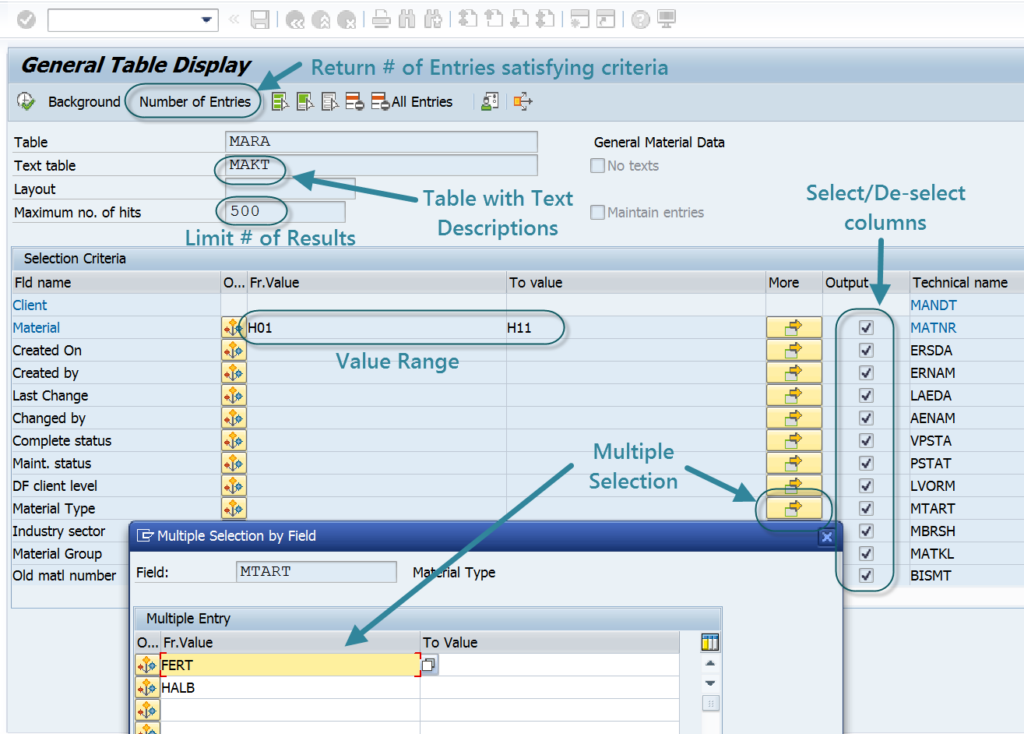
When you first fire up SE16n, the first thing you’ll want to do is input or select your table and hit ‘Enter’. The lower half of the screen (Selection Criteria) then presents all the table fields in one giant list:
- Field Name – This column contains the text description of the field.
- From and To range selection – You can input a single value in the “From” column, or also include the “To” value to select a range of records.
- Multiple selection button – This allows you to specify multiple single values. Importantly, this also includes an ‘Upload from clipboard’ option.
- Output column – Place a checkbox here to include that field as a column on the results screen. By default, all fields are active, but you can use the Deselect All option to clear out all fields and only select the ones you wish to see.
- Technical field name – This is the technical name of the field used by the database, queries, ABAP code, etc.
The real power here is to quickly and easily select the desired scope of columns and quick access to maintaining the selection criteria.
PRO TIP: You can use the Ctrl-F key combination to do a text search for field descriptions or technical field names to quickly find what you’re looking for.
You will also see the ‘Maximum no. of hits’ field. This limits the number of records displayed on the results screen for performance reasons. Typically, this defaults to 500 records, but you can change the value of this field (or remove it altogether) to show more results. You will also see a Layout field which you can use to specify a pre-defined layout on your results screen.
SE16n can also conveniently bring in a related text description from a related text table. For example, when you specify table MARA (Material Basic Data), SAP will automatically present the text table MAKT in the ‘Text table’ field and the related text fields will be appended to the bottom of the list. If you execute the transaction, the material descriptions will be brought into the results screen, which is handy. If, for some strange reason, you do not wish to see the texts in the results, you can select the ‘No texts’ checkbox on the initial screen.
The results screen
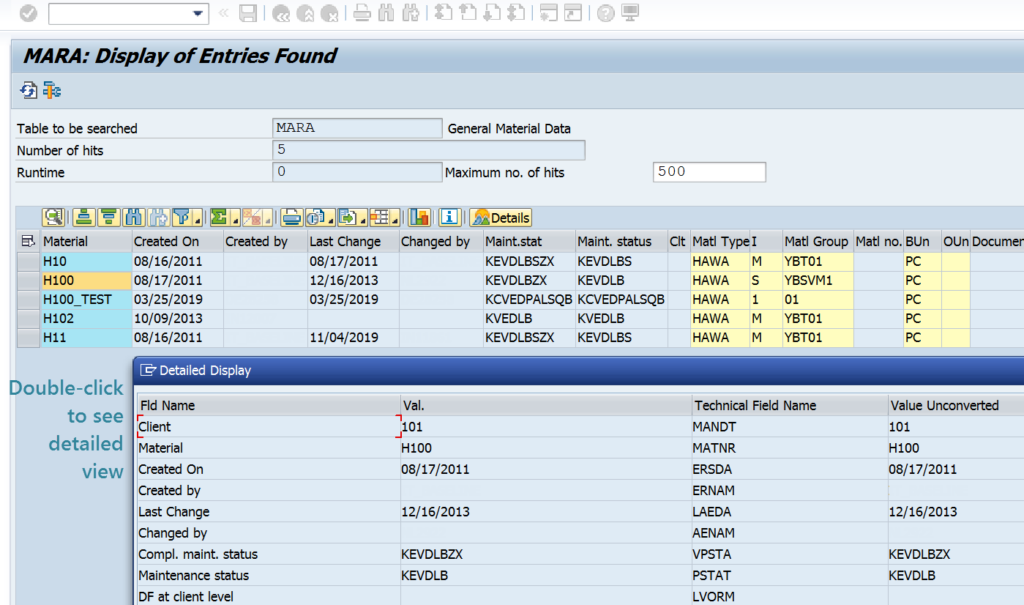
Unlike SE16, the report results is presented using the ALV format. This means you get all the sorting, filtering, exporting, and layout options you’re accustomed to on other ALV reports.
The top of the screen also presents the current number of records in your results screen. Please note, though, that this will be limited to the ‘Max Number of Hits’ value from the prior screen. You can quickly change the Max Number of Hits at the top of the results screen and click ‘Refresh’ to expand or shrink your data set.
Double-clicking on the record will bring up the ‘Detailed Display’ pop-up window which gives you the field Field Name, value, and Technical field name for all the record’s fields.
For any SQL nerds out there, you can also see the corresponding SQL query by clicking the ‘Display Selection Criteria’ button (Hammer and Wrench icon).
Customize Your SE16n Experience using Personalized Settings
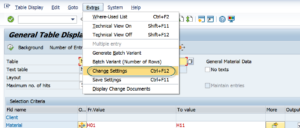
From the initial screen, you can select the ‘Change Settings’ option. A pop-up window presents some advanced options to tailor your SE16n functionality. Here’s a quick rundown of these settings:
- Technical Name as Column Heading – When active, the column headings of the results screen will contain the technical field name.
- Key Columns Scrollable – By default, the key columns in the results screen are frozen against the left side of the screen and are always visible when scrolling to the right. This option removes that “freeze”.
-
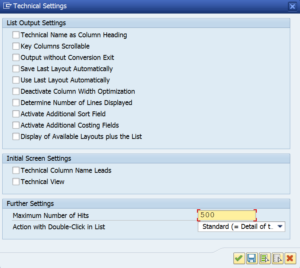
SE16n: Settings Screen
Output Without Conversion Exit – By default, SAP will perform some small ‘conversions’ before presenting the data. For example, leading zeros may be removed, or user language may be considered for some values. Selecting this option will prevent such conversions from being performed. - Save Last Layout Automatically
- Use Last Layout Automatically
- Deactivate Column Width Optimization – By default, the results screen will automatically adjust column size to display data efficiently. This setting disables this feature.
- Determine Number of Lines Displayed – While I’m not 100% sure what this does, it appears to dynamically determine the maximum possible number of table entries and place it in the ‘Max. no of hits’ field.
- Activate Additional Sort Field – This one is pretty interesting. Activating this field appends a new column on the results screen called “Sort”. The user can then manually, temporarily add values to records. This column can then be used as an ALV sort and filtering criterion. I’ve never used this, but could maybe see how this could come in handy.
- Activate Additional Costing Fields
…and there are additional settings which I have not dug into yet.
Is there any reason to use SE16 at all?
I do still use the old SE16 occasionally. There is one use case that I have difficulty with in SE16n. I find it difficult to exclude a list of single values. For example, lets say you wish to find SD document types in use that are NOT ‘OR’, ‘CR’, and ‘DR’. SE16 has a handy ‘Exclude Single Values’ list that can be used for this purpose and I am unable to find an easy alternative in SE16n. If you know of one, please let me know in the comments.
Wrap-up
There you have it: SE16n offers superior functionality and flexibility in an easier-to-use package. Are you still using SE16, or find SE16n to be lacking in certain areas? Let me know in the comments below. Thanks for reading.

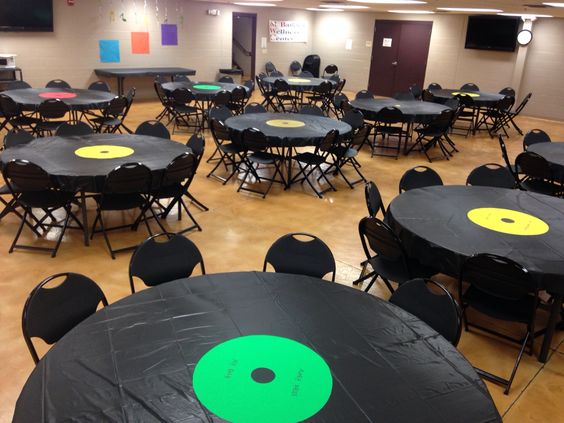
Leave a Reply